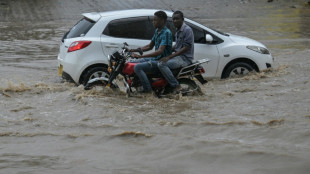
-
 Kenya's economy faces climate change risks: World Bank
Kenya's economy faces climate change risks: World Bank
-
Campaigning starts in Central African Republic quadruple election

-
 'Stop the slaughter': French farmers block roads over cow disease cull
'Stop the slaughter': French farmers block roads over cow disease cull
-
First urban cable car unveiled outside Paris

-
 Why SpaceX IPO plan is generating so much buzz
Why SpaceX IPO plan is generating so much buzz
-
US unseals warrant for tanker seized off Venezuelan coast

-
 World stocks mostly slide, consolidating Fed-fuelled gains
World stocks mostly slide, consolidating Fed-fuelled gains
-
Crypto firm Tether bids for Juventus, is quickly rebuffed

-
 UK's king shares 'good news' that cancer treatment will be reduced in 2026
UK's king shares 'good news' that cancer treatment will be reduced in 2026
-
Can Venezuela survive US targeting its oil tankers?

-
 Salah admired from afar in his Egypt home village as club tensions swirl
Salah admired from afar in his Egypt home village as club tensions swirl
-
World stocks retrench, consolidating Fed-fuelled gains

-
 Iran frees child bride sentenced to death over husband's killing: activists
Iran frees child bride sentenced to death over husband's killing: activists
-
World stocks consolidate Fed-fuelled gains

-
 France updates net-zero plan, with fossil fuel phaseout
France updates net-zero plan, with fossil fuel phaseout
-
Stocks rally in wake of Fed rate cut

-
 EU agrees recycled plastic targets for cars
EU agrees recycled plastic targets for cars
-
British porn star to be deported from Bali after small fine

-
 British porn star fined, faces imminent Bali deportation
British porn star fined, faces imminent Bali deportation
-
Spain opens doors to descendants of Franco-era exiles

-
 Indonesia floods were 'extinction level' for rare orangutans
Indonesia floods were 'extinction level' for rare orangutans
-
Thai teacher finds 'peace amidst chaos' painting bunker murals

-
 Japan bear victim's watch shows last movements
Japan bear victim's watch shows last movements
-
South Korea exam chief quits over complaints of too-hard tests

-
 French indie 'Clair Obscur' dominates Game Awards
French indie 'Clair Obscur' dominates Game Awards
-
South Korea exam chief resigns after tests dubbed too hard

-
 Asian markets track Wall St record after Fed cut
Asian markets track Wall St record after Fed cut
-
Laughing about science more important than ever: Ig Nobel founder

-
 Vaccines do not cause autism: WHO
Vaccines do not cause autism: WHO
-
Crypto mogul Do Kwon sentenced to 15 years for fraud: US media

-
 'In her prime': Rare blooming of palm trees in Rio
'In her prime': Rare blooming of palm trees in Rio
-
Make your own Mickey Mouse clip - Disney embraces AI

-
 OpenAI beefs up GPT models in AI race with Google
OpenAI beefs up GPT models in AI race with Google
-
Dark, wet, choppy: Machado's secret sea escape from Venezuela

-
 Cyclone causes blackout, flight chaos in Brazil's Sao Paulo
Cyclone causes blackout, flight chaos in Brazil's Sao Paulo
-
2024 Eurovision winner Nemo returns trophy over Israel's participation

-
 US bringing seized tanker to port, as Venezuela war threats build
US bringing seized tanker to port, as Venezuela war threats build
-
Make your own AI Mickey Mouse - Disney embraces new tech

-
 Time magazine names 'Architects of AI' as Person of the Year
Time magazine names 'Architects of AI' as Person of the Year
-
Floodworks on Athens 'oasis' a tough sell among locals

-
 OpenAI, Disney to let fans create AI videos in landmark deal
OpenAI, Disney to let fans create AI videos in landmark deal
-
German growth forecasts slashed, Merz under pressure

-
 Thyssenkrupp pauses steel production at two sites citing Asian pressure
Thyssenkrupp pauses steel production at two sites citing Asian pressure
-
ECB proposes simplifying rules for banks

-
 Stocks mixed as US rate cut offset by Fed outlook, Oracle earnings
Stocks mixed as US rate cut offset by Fed outlook, Oracle earnings
-
Desert dunes beckon for Afghanistan's 4x4 fans

-
 Breakout star: teenage B-girl on mission to show China is cool
Breakout star: teenage B-girl on mission to show China is cool
-
Chocolate prices high before Christmas despite cocoa fall

-
 Austria set to vote on headscarf ban in schools
Austria set to vote on headscarf ban in schools
-
Asian traders cheer US rate cut but gains tempered by outlook


An overview of NASA's Artemis 1 mission to the Moon
NASA's Artemis 1 mission, scheduled to take off on Monday, is a 42-day voyage beyond the far side of the Moon and back.
The meticulously choreographed uncrewed flight should yield spectacular images as well as valuable scientific data.
- Blastoff -
The giant Space Launch System rocket will make its maiden flight from Launch Complex 39B at Kennedy Space Center in Florida.
Its four RS-25 engines, with two white boosters on either side, will produce 8.8 million pounds (39 meganewtons) of thrust -- 15 percent more than the Apollo program's Saturn V rocket.
After two minutes, the thrusters will fall back into the Atlantic Ocean.
After eight minutes, the core stage, orange in color, will fall away in turn, leaving the Orion crew capsule attached to the interim cryogenic propulsion stage.
This stage will circle the Earth once, put Orion on course for the Moon, and drop away around 90 minutes after takeoff.
- Trajectory -
All that remains is Orion, which will fly astronauts in the future and is powered by a service module built by the European Space Agency.
It will take several days to reach the Moon, flying around 60 miles (100 kilometers) at closest approach.
"It's going to be spectacular. We'll be holding our breath," said mission flight director Rick LaBrode.
The capsule will fire its engines to get to a distant retrograde orbit (DRO) 40,000 miles beyond the Moon, a distance record for a spacecraft rated to carry humans.
"Distant" relates to high altitude, while "retrograde" refers to the fact Orion will go around the Moon the opposite direction to the Moon's orbit around the Earth.
DRO is a stable orbit because objects are balanced between the gravitational pulls of two large masses.
After passing by the Moon to take advantage of its gravitational assistance, Orion will begin the return journey.
- Journey home -
The mission's primary objective is to test the capsule's heat shield, the largest ever built, 16 feet (five meters) in diameter.
On its return to the Earth's atmosphere, it will have to withstand a speed of 25,000 miles per hour and a temperature of 5,000 degrees Fahrenheit (2,760 degrees Celsius).
Slowed by a series of parachutes until it is traveling at less than 20 miles per hour, Orion will splashdown off the coast of San Diego in the Pacific.
Divers will attach cables to tow it in a few hours to a US Navy ship.
- The crew -
The capsule will carry a mannequin called "Moonikin Campos," named after a legendary NASA engineer who saved Apollo 13, in the commander's seat, wearing the agency's brand new uniform.
Campos will be equipped with sensors to record acceleration and vibrations, and will also be accompanied by two other dummies: Helga and Zohar, who are made of materials designed to mimic bones and organs.
One will wear a radiation vest while the other won't, to test the impacts of the radiation in deep space.
- What will we see? -
Several on-board cameras will make it possible to follow the entire journey from multiple angles, including from the point of view of a passenger in the capsule.
Cameras at the end of the solar panels will take selfies of the craft with the Moon and Earth in the background.
- CubeSats -
Life will imitate art with a technology demonstration called Callisto, inspired by the Starship Enterprise's talking computer.
It is an improved version of Amazon's Alexa voice assistant, which will be requested from the control center to adjust the light in the capsule, or to read flight data.
The idea is to make life easier for astronauts in the future.
In addition, a payload of 10 CubeSats, shoebox-sized microsatellites, will be deployed by the rocket's upper stage.
They have numerous goals: studying an asteroid, examining the effect of radiation on living organisms, searching for water on the Moon.
These projects, carried out independently by international companies or researchers, take advantage of the rare opportunity of a launch into deep space.
A.Samuel--CPN
